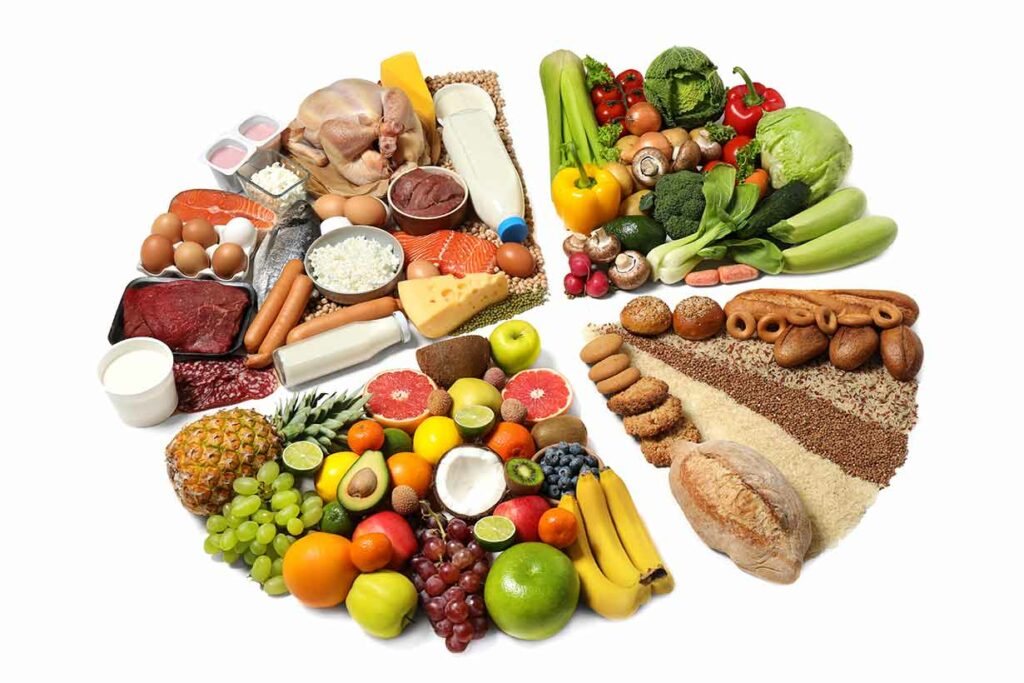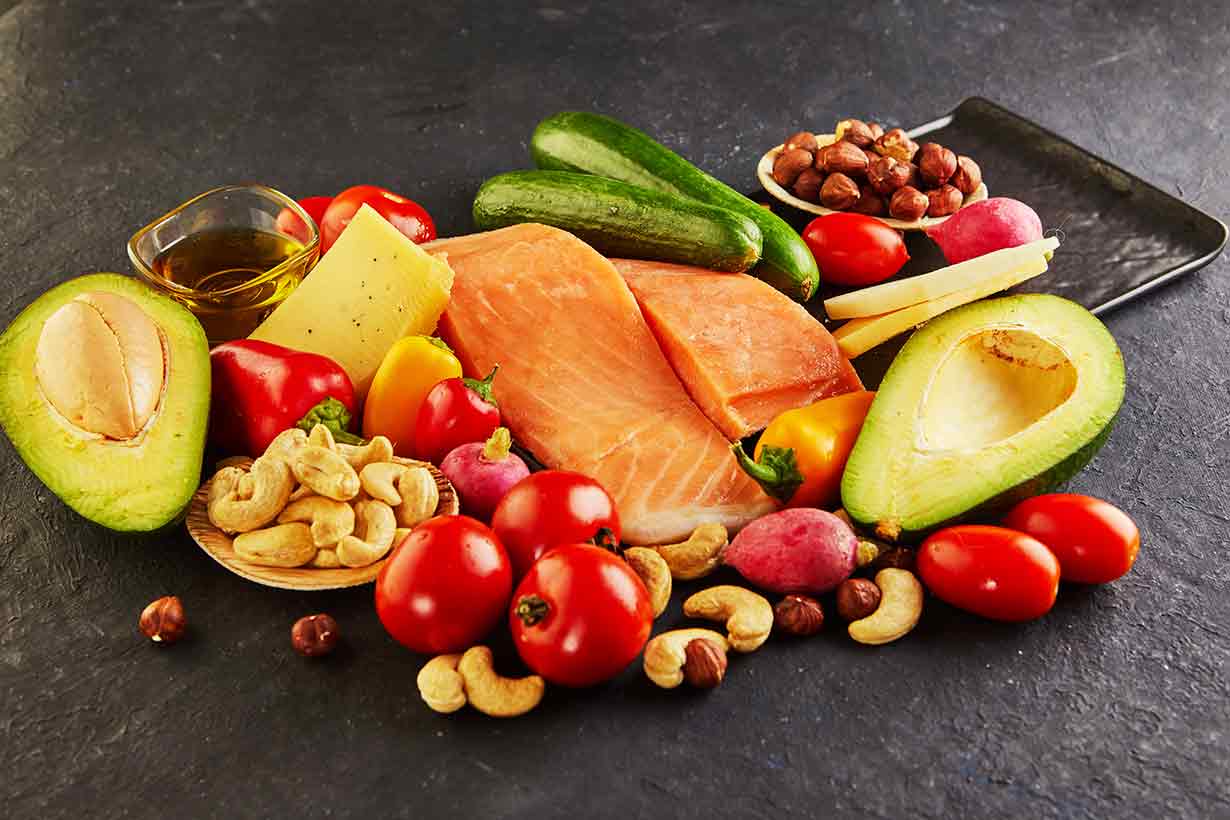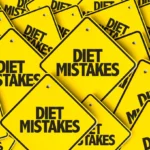16 Popular Types of Diet: How Do They Compare?
Most of us have tried different diets from time to time. And for those of us familiar with social media, it is very easy to hear claims that all kinds of diets are “the best.”
However, the simple truth is that there is no “best diet.”
Different diets suit different people, and trying to stick to an unenjoyable diet is simply a futile challenge that will eventually fail. Instead, a good diet should consider the individual, their unique likes and dislikes, beliefs, and much more.
So, what different types of diets are there, and what are the potential pros and cons of each one?
This article takes a look at 16 popular types of diets and how they compare.

Table of contents
Atkins
Atkins is a high-protein diet that achieved global popularity in the early 2000s.
It was the brainchild of a physician, Dr. Robert Atkins, and it is a low-carbohydrate, high-protein approach. But, unlike some low-carb diets, Atkins isn’t necessarily a high-fat diet.
While the approach has been controversial, many followers have claimed it is effective for weight loss.
Numerous clinical trials have examined the Atkins diet. On this note, a systematic review of the literature noted that nine out of ten short-term (<6 months) clinical trials demonstrated that the Atkins diet led to significant short-term weight loss. Over the longer term (>12 months), six out of eight trials found that participants effectively lost weight (1).
However, Atkins cuts a lot of perfectly healthy foods out of the diet. According to ‘phase 1’ of the diet, only 20 grams of carbohydrate per day are “allowed” (2).
Thus, this strictly limits the intake of foods like fruit, vegetables, legumes, and whole grains. Nevertheless, nutritional research consistently finds these foods to have benefits (3, 4, 5).
The more lenient version of Atkins is known as ‘Atkins 100’ and allows 100 grams of dietary carbohydrate per day (6).
Example Meals
- Salmon, leafy green vegetables cooked in butter/oil, mushrooms
- Steak, bell peppers, onions, asparagus
- Marinated tofu, spinach, edamame
Carnivore Diet
The carnivore diet is a way of eating that restricts all plant foods, and it has become popular over the past few years. Although various iterations (marketing) of the diet have sprung up, some of which “allow” certain plant foods, the diet is characterized by its animal-food focus.
By its very nature, the carnivore diet is basically at odds with dietary guidelines from countries worldwide.
On the positive side, some animal-based foods—especially organ meats and shellfish—are exceptionally nutrient-dense, meaning they provide a broad range of nutrients per serving.
Conversely, the carnivore diet eliminates a wide range of perfectly healthy plant-based foods. For individuals with genuine sensitivities or allergies to particular plant foods, it is claimed that this may potentially help as an elimination diet of sorts.
However, for most people, the diet needlessly cuts out a significant range of nutrient-rich, beneficial foods. Further, the diet makes obtaining the recommended amount of essential nutrients like magnesium and vitamins C and E difficult.
Many people claim to have success with the diet in terms of weight loss. Since the diet emphasizes whole (animal) foods, this may help with satiety (satisfying hunger) due to food volume and protein content. Research has demonstrated that these factors are important for satiety and appetite regulation (7, 8, 9).
There is no long-term research of note on the carnivore diet.
Example Meals
- Beef liver with fried eggs
- Ribeye steak and shrimp cooked in butter
- Chicken drumsticks
For a full review, see this guide to the carnivore diet
DASH
The ‘Dietary Approaches to Stop Hypertension’ (DASH) diet is an eating pattern designed to help normalize blood pressure and prevent hypertension.
DASH has big backers too, with the National Institutes of Health recommending it based on results from clinical trials. These studies found that the diet lowered blood pressure and improved the participants’ cholesterol (lipid) profile (10).
At its heart, DASH is a plant-rich, low-fat diet that emphasizes fruit and vegetables, grains, legumes, nuts, seeds, lean meat, low-fat dairy, poultry, and fish. It is also relatively low in salt, saturated fat, and sugar (10).
Systematic reviews and meta-analyses have demonstrated that DASH improves cardiovascular risk factors (cholesterol, blood pressure) and appears to lower the risk of all-cause and cause-specific mortality (11, 12, 13, 14).
On the downside, these results are only possible if people successfully adhere to the diet, and not everyone does. In a systematic review of observational studies on DASH, there was a dose-response greater protection based on higher adherence. High and moderate adherence to the diet significantly lowered risk compared to low adherence (15).
This is why eating patterns should be tailored to the individual’s preferences; it is much easier to adhere to a diet that you enjoy.
Example Meals
- Tempeh, sweet potato, spinach
- Chicken curry, brown rice, peas and carrots
- Grilled cod, wholewheat pasta, bell peppers, tomatoes
The Dietary Guidelines
While not a “diet” as such, the Dietary Guidelines are a broad range of recommendations intended to help the population eat more healthily. The guidelines are based on the totality of current high-level evidence from nutritional research (16).
The guidelines promote a way of eating that emphasizes dairy, fruit and vegetables, whole grains, lean meat, legumes, nuts, seeds, poultry, and seafood (17).
A common criticism of the guidelines is that population health (particularly obesity and type 2 diabetes) has worsened since their introduction. However, research demonstrates that, around the world, most people don’t adhere to their national dietary guidelines (18).
Is there a reason for this? The fact that people don’t follow the guidelines (often despite trying to) is a legitimate criticism that warrants debate on their effectiveness/communication.
That said, the criticism that the guidelines “don’t work” if followed is incorrect.
Research has demonstrated that the closer people adhere to the guidelines, the better their health outcomes (19, 20, 21, 22).
Example Meals
- Lean beef and kidney bean chilli with baked potato
- Salmon, brown rice with mixed vegetables
- Barley and lentil stew with wholewheat bread
Ketogenic Diet
Ketogenic diets are a way of eating that strictly restricts carbohydrate intake, with the maximum level usually being around 50 grams per day.
Unlike diets such as the carnivore diet, ketogenic (or ‘keto’ for short) diets can feature various animal and plant foods. These diets are often used for weight loss and to help control the symptoms of type 2 diabetes.
In this regard, clinical trials have shown mixed results on ketogenic diets. On the one hand, numerous randomized controlled trials have shown that ketogenic diets can lead to weight loss (23, 24, 25).
However, like any diet, successful adherence can be an issue with ketogenic diets. In a systematic review of thirteen randomized controlled trials, dropout rates ranged from 13% to 84% (26).
A further meta-analysis of twelve trials on ketogenic diets for intractable epilepsy demonstrated a combined adherence rate of 45% (27).
Understandably, restricting carbohydrate intake to such a low level is not the right fit for everybody. But for those who enjoy the diet, ketogenic diets can be a nutrient-rich way of eating if formulated in the right way.
See this full evidence-based guide to ketogenic diets for more information on the diet.
Example Meals
- Seafood and mixed vegetable stir-fry with cauliflower rice
- Roast chicken with spinach, mushrooms, and bell peppers
- Smoked salmon, lupin beans, avocado, and berries
Low-carbohydrate Diet
General low-carbohydrate (or ‘low-carb’) diets are much more relaxed than stricter versions like the ketogenic diet.
However, there is a distinct lack of standardized definition for a low-carb diet, so opinions will understandably vary. Randomized controlled trials have called anything up to 30% of calories from carbohydrate ‘low-carb’ (28).
This carbohydrate amount would be equivalent to 150 grams per day on a standard 2000 calorie diet.
Interestingly, the American Academy of Family Physicians has attempted to define a low-carbohydrate diet. Their definition classes any diet with less than 20% of calories from carbohydrates as low-carb (29).
There are numerous different interpretations of low-carb diets, and they range from healthful to somewhat questionable. That said, if formulated correctly, low-carb diets can be a perfectly nutritious way of eating.
On the positive side, a recent systematic review of systematic reviews provided clear evidence that low-carb diets can have beneficial effects for overweight and obesity. However, there was no good evidence to support low-carb above other dietary approaches for weight loss (30).
Some common concerns raised about low-carb diets include them being low in fiber or excessively high in saturated fat, but neither of these points has to be true. For instance, many sources of fiber can fit into a low-carb diet, such as berries, legumes, avocados, nuts, seeds, and more.
Further, a low-carb diet doesn’t have to mean ‘high saturated fat.’
Example Meals
- Lamb chop, sweet potato fries, grilled tomato, mushrooms
- Sardines with avocado, cheese, and salsa
- Tofu and root vegetable stew
Low-fat Diet
Low-fat diets are the complete opposite of low-carb, and they restrict fat intake to an upper limit of around 20-30% of calories. Based on a 2000 calorie diet, this equals approximately 45 to 66 grams of dietary fat per day (31, 32).
By their very nature, low-fat diets tend to have a high carbohydrate content, emphasizing fruit, grains, legumes, and vegetables. A variety of randomized controlled trials have demonstrated that these diets can effectively lead to weight loss (if adhered to). However, they appear to have roughly the same efficacy as low-carbohydrate diets in this regard, so personal preference is the decider (33, 34, 35, 36).
One potential downside of low-fat diets is that fat intake can be taken too low. Dietary fat has numerous functions within the human body, and an adequate intake level is vital for the optimal absorption of fat-soluble vitamins.
‘Fat-soluble’ means that the nutrient doesn’t dissolve in water like some (such as vitamin C) do, and they need to be emulsified (and absorbed) with dietary fat. These fat-soluble vitamins include vitamins A, D, E, and K (37, 38).
There was a clinical trial that demonstrated an example of this fat-soluble vitamin absorption in action. In this study, 50 healthy older adults consumed vitamin D alongside a meal with either 30% of calories from fat or a fat-free meal. Those consuming the meal containing fat had a 32% higher peak plasma vitamin D level than the participants with the fat-free meal (39).
In other words: it should be low-fat, but not no fat.
Example Meals
- Wholewheat toast topped with hummus, piece of fruit
- Chicken breast, lentils, and vegetables
- Rice bowl with lean beef, vegetables, soy sauce, and seasonings
Mayo Clinic Diet
The Mayo Clinic is an American healthcare company that provides education and healthcare as well as undertaking research.
In addition to employing thousands of scientists and healthcare professionals, the company runs the supposed “best hospital” in the United States, according to U.S. News rankings between 2016 and 2021 (40).
The Mayo Clinic diet has two phases; phase 1 (‘lose it!’) and phase 2 (‘live it!’), with the former designed to aid weight loss and the latter to maintain it (41).
While the diet encourages the restriction of refined grains, sugary foods, and processed meats, it doesn’t wholly restrict any particular food.
Instead, the diet focuses on eating to a particular calorie intake – with multiple calorie ranges suggested based on current weight and goals. Then, provided meal plans and example meals help each person following the diet to meet these calorie targets.
However, the diet generally follows ‘the Mayo Clinic Pyramid,’ which emphasizes eggs, fruit, legumes, low-fat dairy, seafood and poultry, unsaturated fats (such as avocados and olive oil), vegetables, and whole grains.
In other words, it is a moderate-high carbohydrate, low-ish fat, and moderate protein diet pattern that quite firmly sticks to the dietary guidelines.
Example Meals
- Wholegrain tortilla, eggs, low-fat Cheddar, salsa
- Wholegrain cous cous, vegetables, extra virgin olive oil, herbs and spices
- Chicken stir-fried with vegetables, chicken stock, extra virgin olive oil, herbs and spices
Mediterranean Diet
In truth, despite the name, there is no such thing as one ‘Mediterranean diet,’ and there are many diverse diets within the region.
However, the popular recognized meaning of ‘the Mediterranean diet’ is an eating pattern that emphasizes fresh, whole foods. These foods include a high intake of fruits, legumes, nuts, olive oil, seeds, vegetables, and a moderate intake of meat, poultry, and seafood. A reasonable amount of red wine may also be included if desired (42, 43).
The diet is described as having only a low intake of eggs and sweet foods.
Overall, most of the research on Mediterranean diets has focused on the above description for their formulation. Notably, the Mediterranean diet arguably has more research on it than any other diet, and this research tends to be positive.
To illustrate this, systematic reviews and meta-analyses analyzing observational studies and randomized controlled trials have suggested that the diet may improve health markers like blood pressure and cholesterol levels. Additionally, the diet may also lower the risk of cardiovascular and all-cause mortality (44, 45, 46, 47).
Despite the potential health benefits of the diet, it doesn’t mean it is better than other dietary patterns for weight loss. On this note, a systematic review of Mediterranean diet interventions for long-term weight loss found that the diet was only equally as effective as low-carb, low-fat, and other comparator diets (48).
Once again, this shows that there is no ‘one diet’ that is the right fit for all.
Example Meals
- Seafood stew with tomatoes, garlic, and herbs and seasonings
- Leafy green salad with tomatoes, red onions, feta cheese, olive oil and seasonings
- Seasoned chicken with tahini and salad in wholegrain pitta bread
Nordic Diet
The Nordic diet, based on the traditional diets and foods of the Nordic region, is one of the lesser-known eating patterns. These Nordic countries and places include the Aaland Islands, Denmark, Faroe Islands, Finland, Greenland, Iceland, Norway, and Sweden.
Generally speaking, the diet focuses on home-cooked whole food-based meals and limiting the intake of heavily processed foods. The diet incorporates fruits, legumes, meat, nuts, seafood like oily fish, seeds, vegetables, vegetable oil, whole grains, and herbs and spices.
Research on the Nordic diet has shown that it tends to meet existing dietary guidance for nutrient intake. It is also moderate to high in carbohydrates with moderate amounts of fat and protein, with most of the fat content coming from fish and plants (49).
There has been quite a lot of research into the Nordic diet. A systematic review and meta-analysis of randomized controlled trials found that following the diet improved blood cholesterol and blood pressure markers (50).
A further systematic review and meta-analysis of randomized controlled trials demonstrated that the diet led to weight loss for those who adhered to it. Across seven studies, participants following the Nordic diet experienced 1.83kg more weight loss than control diets (51).
As with all dietary patterns for weight loss, the ‘adherence’ part is the important bit.
Example Meals
- Pickled herring with wholegrain rye bread and mustard
- Smoked salmon salad with baby potatoes, red onions, and carrots
- Pork tenderloin with root vegetables and mushrooms
Learn more about the Nordic Diet and see all the research behind it here:
What is the Nordic Diet and Is It a Healthy Choice?
Paleo Diet
The paleo (or paleolithic) diet is a way of eating presumed to follow an ancestral eating pattern. In summary, the idea of the diet is that eating closer to how our ancestors ate throughout evolution would be beneficial for the human body.
However, it is important to note that people in the paleolithic era had restricted food choices and a lack of knowledge on the nutritional effects of different foods. In other words, just because people used to eat in a particular way doesn’t necessarily mean it is the optimal way of eating now.
Additionally, it is worth noting that we don’t know exactly how people used to eat, and it likely depended on the specific time and locale. Some interpretations of the historical paleolithic diet suggest it was focused on animal foods, but others claim animal foods may have only played a small part (52).
That being said, the mainstream modern interpretation of the ‘paleo diet’ is a way of eating that includes fruits, vegetables, nuts, eggs, lean meat, and seafood. The diet also restricts dairy products, grains, legumes, and processed foods (53).
While the diet restricts an extensive range of foods, it is still possible to formulate a healthy range of meals.
However, there is no real reason to restrict all the foods that paleo diets restrict, and dairy, legumes, and whole grains are all nutrient-rich foods that can fit into healthy dietary patterns.
What does the research show?
A systematic review of randomized controlled trials claimed that well-formulated versions of the diet might improve health markers of metabolic syndrome (54). That said, this scientific paper had some questionable interpretations, and many of the results weren’t statistically significant, suggesting there may have been no effect at all (55).
Other research shows that paleo diets can lead to short-term weight loss, but there are question marks over whether this can be sustained long-term (56, 57).
Example Meals
- Bell pepper stuffed with ground beef and vegetables
- Grilled mackerel with sauteed mushrooms and asparagus
- Stir-fried beef, mushrooms, onions, and peppers
Pescetarian Diet
Pescetarianism is a way of eating that excludes animal products except for seafood. Aside from this, it neither limits nor restricts any other type of food.
Put another way, the pescetarian diet is a vegan diet plus seafood.
Since seafood has most of the same nutrients as meat, this also removes some of the nutrients of concern that would otherwise be present in a vegan diet. For example, fish is an excellent source of vitamin B12, which vegans would otherwise have to supplement, and also contains preformed omega-3s EPA and DHA.
One potential form of pescetarian diet is a vegan diet that also includes bivalve shellfish (such as clams, mussels, and oysters) known as ‘ostroveganism’. While it is a controversial and debated issue, some vegans feel these shellfish can fit into veganism as they are likely not sentient.
Example Meals
- Grilled sardines, root vegetables, baked potato with hummus
- Rice and kidney beans cooked in coconut milk with vegetables
- Seafood chowder with potatoes and vegetables
Vegan (Plant-Based)
There is some confusion between the terms ‘vegan’ and ‘plant-based.’
Being vegan involves avoiding all animal products, whether food or clothing (such as leather shoes). In contrast, plant-based refers to foods and meals that are predominantly based on plants.
Perhaps confusingly, plant-based diets are sometimes assumed to contain no animal products. This is mainly because ‘plant-based’ has become something of a marketing term for vegan diets.
However, plant-based diets can include animal products, and dietary organizations such as the American Dietetic Association refer to plant-exclusive diets as ‘vegan diets’ (58).
Vegan diets restrict all animal products including all types of meat, poultry, seafood, eggs, and dairy. As a result, the diet requires either the supplementation of vitamin B12 or the inclusion of B12-fortified foods, as this nutrient is found exclusively in animal foods (59).
There are also other nutrients that can be more difficult to obtain in sufficient quantities on vegan diets, including long-chain omega-3s (DHA/EPA), calcium, zinc, and vitamin D (58).
On the positive side, vegan diets tend to focus on lots of whole food plants such as fruits, vegetables, lentils, nuts, seeds, and whole grains. These foods are consistently associated with health benefits (60).
While long-term data on vegetarian diets exists, this is lacking for vegan diets. Short-term trials show that well-planned vegan diets may have various benefits, but it is unlikely they are solely due to the plant-exclusive aspect of the diet (61, 62, 63).
Example Meals
- Marinated tofu, miso soup, vegetable side dish
- Lentil curry
- Pea protein guacamole with wholewheat toast
See this objective and in-depth guide to vegan diets for more information.
Vegetarian
Vegetarian diets restrict the consumption of all meat, poultry, and seafood. However, they can include various products of animal agriculture such as cheese, eggs, and milk.
Nutritionally, vegetarian diets contain a broader range of foods than vegan diets and do not have the same nutrients of concern. One reason for this is because cheese, eggs, and milk are all rich sources of vitamin B12 (64).
As a result, depending on the specific diet, vegetarians do not necessarily have to supplement vitamin B12 or consume B12-fortified foods.
There do not appear to be any long-term concerns with vegetarian diets, and they may even offer benefits. For instance, a large observational trial that followed 96,469 people over roughly six years found that vegetarians had a 12% lower all-cause mortality risk over the period (65).
However, it is very difficult to determine, but this may not be because of the vegetarian aspect (rather than the overall pattern) of the diet.
Additionally, not all studies show the same outcome. For instance, a large Australian study that followed 267,180 people for six years found no difference in all-cause mortality between vegetarians and non-vegetarians (66).
Example Meals
- Cheese omlet with vegetables
- Marinated and baked tofu with stir-fried vegetables
- Feta cheese, cherry tomato, and olive salad
Whole 30
Whole 30 is a diet that achieved popularity in the early 2010s, and it was marketed as an ‘elimination diet’ despite basically being a rebranded paleo diet.
However, the diet was (probably fairly) criticized in the media for its indiscriminate banning of particular foods.
For instance, the couple who created the plan deemed that if anyone had energy, stress, or weight issues, eliminating alcohol, dairy, grains, legumes, and sugar would help them recover. From there, they could supposedly re-add each type of food to see which one is the culprit.
Despite these points, one thing that ‘whole 30’ does right is its focus on whole foods. A diet of eggs, fruit, meat, nuts, seafood, seeds, and vegetables contains a wealth of nutrients and eliminates lots of energy-dense, ultra-processed foods.
However, the problem is that the diet also eliminates lots of perfectly nutritious foods with no good evidence to explain why.
There is no peer-reviewed scientific research on the whole 30 diet, and thus no strong evidence to support any health claims.
Example Meals
- Scrambled eggs with salmon and vegetables
- Pork chop with vegetables
- Chicken and vegetable soup
WW (Weight Watchers)
The WW diet, formerly known as Weight Watchers, is a way of eating that assigns point values to different foods.
From there, there is a limit on the number of daily points one can eat. At its heart, WW is trying to make the regulation of calories/food intake simpler to understand, which is no bad thing, as many people find this difficult.
WW has changed over the years, and one positive aspect is that it considers personal preference to some degree. WW claims that their plans “guide you toward food choices geared for your preferences” (67).
Another positive side of WW is that it doesn’t restrict any particular food but instead encourages healthier options.
On the negative side, it comes at a cost; there is a (reasonably small) weekly fee to use the service. Furthermore, some people do better with strict guidelines to follow, so WW’s allowance of ‘moderation’ with all foods may not suit everyone.
Additionally, many people dislike tracking calories and macronutrients, and tracking ‘points’ might be equally unwelcome for some.
Overall, the WW diet/app may be very useful for someone who doesn’t wish to follow any particular diet but would welcome help in making meal planning and overall diet quality simpler.
But it won’t be for everyone.
Example Meals
- Homemade hamburgers and salad
- Grilled chicken with herbs and seasonings
- Stir-fried chickpeas and vegetables
What is the Best Diet For Me?
As shown, there are so many different ways of eating to choose from, but the “best diet” will very much depend on the individual.
Firstly, when determining what the right diet might be for you, it is important not to place too much emphasis on what has worked for others.
It can be tempting to give the latest popular diet a go, or the one that is working for a friend or coworker. However, dieting is complicated, and it’s one of many nutrition myths that a particular diet will work for everyone.
For instance, it is possible to find a wide range of claims about how a particular diet “rescued” the health of somebody. This may very well be the case, but whether that diet is plant-based, DASH, ketogenic, carnivore, or any other; it worked for that one specific person.
In other words, just because a way of eating is right for one individual does not mean it is equally the best choice for everyone. Nor does short-term health on a given diet predict longer-term health.
For a larger exploration of dietary mistakes and adherence being the key, see this in-depth guide.
When considering a diet, it is important to focus on:
- Including the foods you enjoy: an unenjoyable way of eating won’t be sustainable in the long-term.
- Prioritize whole foods where possible: whole fruit > juice, potatoes > fried potato products, meat/poultry > processed meat products, and so on.
- Whether the diet suits our lifestyle: constantly busy? Eating six small meals a day won’t be the right fit. Endurance athlete? Regular food intake is important.
- Encouraging satiety: satiety refers to the feeling of being satisfied after eating, and the subsequent lack of desire to eat more. Some foods encourage satiety more than others, and focusing on these foods can help to control appetite and discourage excessive food intake. Foods that tend to be more satiating include protein and fiber-rich foods, as well as foods with greater volume (such as whole potatoes). The satiety index of common foods is an excellent resource for help in this area.
- Ensuring recommended intake of essential nutrients: vitamin B12 supplementation is necessary for vegan diets, and vegetarian/vegan diets can make it harder to obtain sufficient DHA/EPA omega-3 and zinc. In contrast, diets with a lack of plant-based foods can make it harder to obtain adequate levels of magnesium, potassium, and vitamins C and E. It is important to be aware of the nutrients of concern for a particular diet, or to work with a dietitian/nutritionist if this is difficult.
- How the diet effects our health: feeling terrible and constantly struggling to stick to a particular diet isn’t a good sign. It is important to assess how a particular diet makes us feel in this regard. Also, it is always a sensible idea to have some basic health checks after starting a new diet, just to make sure everything is as expected.
Additional Consideration: Budget-Friendly Diets
When we hear about a particular way of eating and all the different health-promoting foods, we sometimes feel like we should be having all these foods.
The fact of the matter is that we can’t eat everything, and it is important to choose foods that fit into our individual food budget.
There are numerous nutrient-rich yet relatively cheap foods from all food groups.
This guide to eating well on a budget provides a list of these, alongside some general food budget tips.





